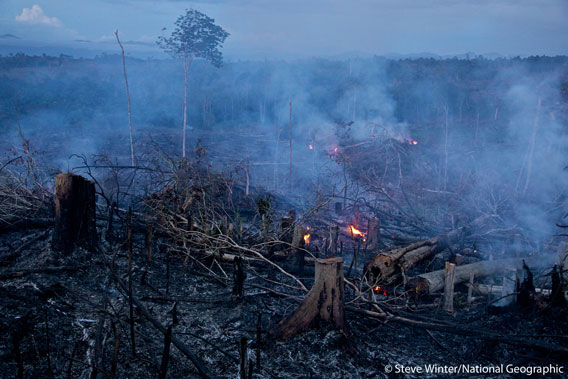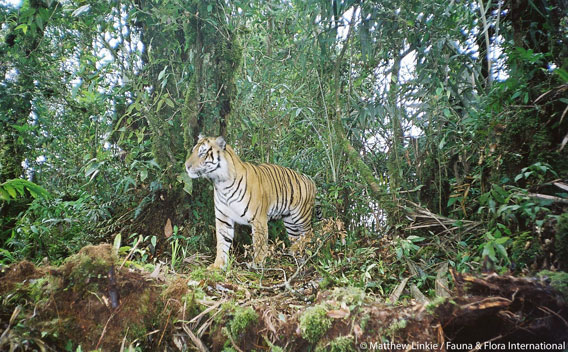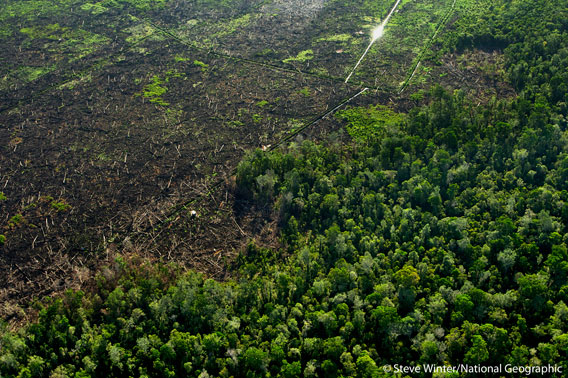
Scorched rainforest in Sumatra. Photo by: Steve Winter/National Geographic.
The first-ever Sumatran-wide survey of the island’s top predator, the Sumatran tiger (Panthera tigris sumatrae), proves that the great cat is holding on even as forests continue to vanish. The study, carried out by eight NGOs and the Indonesian government, shows that the tiger is still present in 70 percent of the forests surveyed, providing hope for the long-term survival of the subspecies if remaining forests are protected.
“This survey is a milestone for Sumatran tigers. The results provide the most up-to-date and reliable information ever collected for this Critically Endangered subspecies and is the first time that such a large number of organizations have worked together so effectively,” lead author Hariyo Wibisono of the Wildlife Conservation Society (WCS) and chairman of the Sumatran Tiger Forum (HarimauKita) said in a press release. WCS was joined by Panthera’s Tigers Forever program, Fauna and Flora International (FFI), and the World Wide Fund for Nature (WWF) among others.
Researchers surveyed 13,500 kilometers of forest transects seeking indirect signs of the tiger, such as footprints. They found new priorities for tiger conservation, including the Leuser-Ulu Masen landscape in Aceh Province.
 Captive Sumatran tiger. Photo by: Rhett A. Butler. |
“This study puts Aceh’s previously unsurveyed forest firmly on the map as a global priority for wild tigers in Asia,” explained co-author Matthew Linkie with FFI. Notably, Aceh has implemented an effective logging moratorium since 2007, preserving its forests. Another region that showed tigers doing well was the Kerinci Seblat-Batang Hari forest landscape.
Still, good news was not found everywhere. Riau Province, where deforestation has been extensive in recent decades, proved that tigers were not surviving in severely degraded forests. The region has the fewest tigers by far, according to the paper.
“Over the past 25 years, Riau has lost 65 percent of its natural forest, so it’s unsurprising that tigers are badly affected here. However, they are still
roaming and breeding in some areas and we’re increasing our conservation efforts in these areas and trying to restore forest corridors between tiger subpopulations,” explains Dr. Sunarto with WWF.
Forests in Riau are falling fast to pulp and paper plantations and palm oil monocultures, making the region the epicenter of a battle between green groups and industry over Sumatra’s dwindling forests. A study by WWF in 2008 found that deforestation in Riau Province alone generated 3.7 gigatons of carbon dioxide from 1982-2007, or an annual rate equivalent to over half of Australia’s annual emissions.
“Sumatra has one of the highest global deforestation rates and the two largest tiger landscapes identified in this study will become highly fragmented if their respective proposed roads networks are approved,” the authors write. “Thus, it is vital that the Indonesian government tackles these threats, e.g. through improved land-use planning, if it is to succeed in meeting its ambitious National Tiger Recovery Plan targets of doubling the number of Sumatran tigers by 2022.”
According to a satellite study this year, Sumatra has lost around 9 percent of its forest cover in the past 8 years.
The Sumatran tiger is Indonesia’s last, since the nation has already lost two distinct subspecies of tiger: the Bali and the Javan. Worldwide the tiger is listed as Endangered with just over 3,000 left in the wild. Despite decades of conservation work, the species continues to decline from habitat loss, poaching, human-wildlife conflict, and a decline in prey. Still, the new survey provides much-needed good news in the fight to save the world’s biggest cat from extinction.
“The survey results provide an excellent benchmark against which to measure how our future conservation efforts are benefiting tigers on the ground,” said co-author Joseph Smith with Panthera. “While the future for wild tigers often appears bleak and is certainly wrought with challenges, this survey shows us that hope still remains.”
CITATION: Wibisono HT, Linkie M, Guillera-Arroita G, Smith JA, Sunarto, et al. (2011) Population Status of a Cryptic Top Predator: An Island-Wide Assessment of Tigers in Sumatran Rainforests. PLoS ONE 6(11): e25931. doi:10.1371/journal.pone.0025931.

Wild Sumatran tiger. Photo by: Matthew Linkie/Fauna and Flora International.

Palm oil plantations replacing rainforest. Photo by: Steve Winter/National Geographic.
EDITOR’S NOTE: The original version of this article misstated Raiu’s emissions as 3.7Gt for 2008, rather than from 1982-2007. Thank you to Jessie Wells for the correction.
Related articles
Ironic conservation: APP touts tiger relocation after allegedly destroying tiger’s home
(08/02/2011) A female Sumatran tiger (Panthera tigris sumatrae) has been relocated from her threatened rainforest home to Sembilang National Park. According to Asia Pulp and Paper (APP) and the Sumatran Tiger Conservation Foundation (YPHS), the tiger had become an issue in its home region due to human and wildlife conflict. The group touted saving the tiger as ‘a significant moment for Sumatran tiger preservation’. However, Greenpeace says that the tiger would never have been a problem if APP were not destroying its habitat.
Video: Tiger trapped in Asia Pulp and Paper logging concession dies a gruesome death
(07/25/2011) Caught in a snare and left for days without access to food and water, a wild Sumatran tiger (Panthera tigris sumatrae) perished from its wounds hours after forest officers reached it. As reported by Greenpeace—which photographed and filmed the rescue attempt—the tiger was trapped at the edge of a acacia plantation and remaining forest area actively being logged by Asia Pulp and Paper (APP) in Riau Province. Sumatran tigers are listed as Critically Endangered by the IUCN Red List; the subspecies, restricted to the Indonesian island, is in decline due to large-scale habitat loss and poaching.

(07/19/2011) We are losing the tiger. Two hundred years ago, Asia’s great cat numbered in the hundreds of thousands and inhabited virtually the entire continent, from Siberia to Turkey, and Afghanistan to Bali. Today there are, at best, around 3,200 wild tigers left. The tiger is extinct in at least 14 countries and hangs on in only 7% of the habitat it once occupied – tiny, mostly isolated fragments in what was once an ocean of forest. Three sub-species, from Bali, Java and Central Asia are lost forever, and a fourth, the South China tiger has not been recorded in the wild for over a decade.
Decline in top predators and megafauna ‘humankind’s most pervasive influence on nature’

(07/14/2011) Worldwide wolf populations have dropped around 99 percent from historic populations. Lion populations have fallen from 450,000 to 20,000 in 50 years. Three subspecies of tiger went extinct in the 20th Century. Overfishing and finning has cut some shark populations down by 90 percent in just a few decades. Though humpback whales have rebounded since whaling was banned, they are still far from historic numbers. While some humans have mourned such statistics as an aesthetic loss, scientists now say these declines have a far greater impact on humans than just the vanishing of iconic animals. The almost wholesale destruction of top predators—such as sharks, wolves, and big cats—has drastically altered the world’s ecosystems, according to a new review study in Science. Although researchers have long known that the decline of animals at the top of food chain, including big herbivores and omnivores, affects ecosystems through what is known as ‘trophic cascade’, studies over the past few decades are only beginning to reveal the extent to which these animals maintain healthy environments, preserve biodiversity, and improve nature’s productivity.
Scientists urge Indonesia to stop road construction in tiger-rich national park

(06/06/2011) The Association for Tropical Biology and Conservation (ATBC) has drafted a resolution urging the Indonesian government to cancel plans to build four 40-foot wide roads through the countries oldest national park, Kerinci Seblat National Park. According to the ATBC, the world’s largest professional society devoted to studying and conserving tropical forests, the road-building would imperil the parks’ numerous species—many of which are already threatened with extinction—including Sumatra’s most significant population of tigers.
Camera traps capture tiger bonanza in Sumatra forest slated for logging
(05/09/2011) Camera traps set in an area of forest slated for logging for paper production captured photos of a dozen critically endangered Sumatran tigers, reports the World Wildlife Fund for Nature (WWF).
Road building plan in Sumatran park threatens Critically Endangered tigers

(05/03/2011) A plan to build four wide roads through Kerinci Seblat National Park in the Indonesian island of Sumatra threatens one of the world’s most viable populations of the Critically Endangered Sumatran tiger subspecies (Panthera tigris sumatrae), reports the AP. Less than 500 Sumatran tigers remain in the wild with the population continuing to decline due to habitat loss from palm oil and paper plantations, poaching, and prey declines.